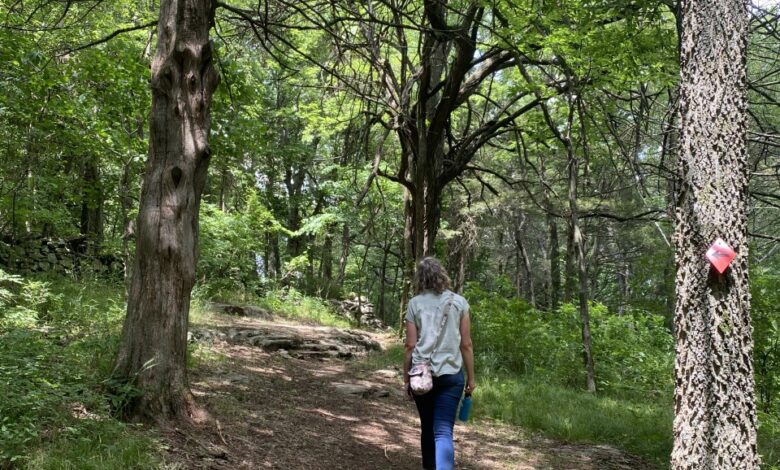Cane Hill boasts hiking trails and historic buildings


If trees could talk, the towering Bur oak in Cane Hill would have some mighty stories to tell.
Estimated to be at least 150 years old, the oak likely grew up among the early settlers of Cane Hill and witnessed the town’s heyday, decline and re-emergence as a historic district with unique hiking trails.
“We call this our witness tree,” Vanessa McKuin, executive director of Historic Cane Hill, said. She added that it’s possible that this tree “witnessed” the Trail of Tears in 1837 and the Civil War Battle of Cane Hill in 1862.
Today, the tree stands about 85 feet tall, overseeing the current grounds of Historic Cane Hill, Inc. Visitors can take advantage of walking trails, historic buildings, exhibits, tours and event space.
Trails and outdoors
Four marked trails run through the 150 acres owned by Historic Cane Hill.
The 1.2-mile Heritage Trail takes hikers past most of the historic properties and up to Cane Hill Cemetery. The Welch Trail is a mere .25-mile stroll by Jordan Creek. Leading past limestone rock faces, the Earle homestead and up to the college is the 1.1-mile Earle Trail. The 1-mile McCullough Trail is a steep hike to an overlook.
The trails show signs of early settlers. Today’s hikers enjoying leisurely walks can appreciate the work it would have taken to carry and stack the rocks for the walls and structure remnants that can be seen.
Outside of the official trails, visitors can also enjoy strolling the grounds, which include the witness tree and a wildflower meadow with plenty of pollinators such as bees and butterflies.
This rural community is a great place for bird watching, hiking and exploring. The property has several picnic tables. The surrounding Ozark Mountains are excellent terrain for road and gravel cycling.
Historic buildings
Established in 1827 by a group of Cumberland Presbyterians, Cane Hill was the first permanent settlement in Washington County. The community was home to one of the state’s first colleges and first coed college. Cane Hill was impacted by the Civil War and struggled to compete with the nearby Arkansas Industrial University, which is now the University of Arkansas in Fayetteville.
A dense collection of this history still stands today in the form of architecture. Cane Hill is home to 17 properties listed on the National Register of Historic Places. Since 2013, Historic Cane Hill has restored or stabilized nine historic buildings. Its current project is to turn the 1898 Queen Anne home on the property into a bed and breakfast inn.
Historic Cane Hill also operates a local history museum and art gallery.
Exhibits, tours and event rentals
Numerous historic buildings are available for tours and events. Pick up a self-guided walking tour and trail map at the Historic Cane Hill office or make an appointment for a guided tour.
Historic Cane Hill regularly hosts programs and special exhibitions, with the annual Cane Hill Harvest Festival in September.
Some of the iconic buildings offer modern uses for weddings, reunions, retreats and conferences. The restored 1886 Cane Hill College building boasts 6,000 square feet and includes an auditorium with A/V equipment that seats 180, a commercial kitchen, a bridal suite and three spacious meeting rooms.
The 1891 Cane Hill Presbyterian Church, seating 100 guests, is available for weddings and other events. Also available for rent are the beautiful grounds and outdoor venues.
Getting there
A trip to Cane Hill is a pleasant drive through the countryside to see nature, architecture and history. The historic community is located 20 miles southwest of Fayetteville, 17 miles northwest of Devil’s Den State Park and three miles south of Lincoln.
For more information, visit historiccanehillar.org.




